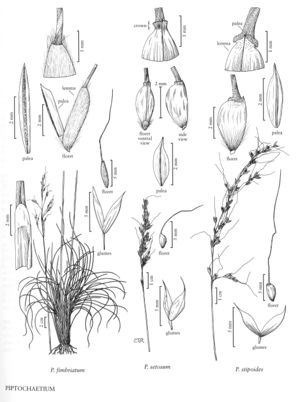Difference between revisions of "Piptochaetium stipoides"
FNA>Volume Importer |
imported>Volume Importer |
||
| (6 intermediate revisions by 2 users not shown) | |||
| Line 7: | Line 7: | ||
|synonyms={{Treatment/ID/Synonym | |synonyms={{Treatment/ID/Synonym | ||
|name=Piptochaetium stipoides var. purpurascens | |name=Piptochaetium stipoides var. purpurascens | ||
| − | |authority= | + | |authority= |
| + | |rank=variety | ||
}} | }} | ||
|hierarchy=Poaceae;Poaceae subfam. Pooideae;Poaceae tribe Stipeae;Piptochaetium;Piptochaetium stipoides | |hierarchy=Poaceae;Poaceae subfam. Pooideae;Poaceae tribe Stipeae;Piptochaetium;Piptochaetium stipoides | ||
| Line 30: | Line 31: | ||
-->{{#Taxon: | -->{{#Taxon: | ||
name=Piptochaetium stipoides | name=Piptochaetium stipoides | ||
| − | |||
|authority=(Trin. & Rupr.) Hack. | |authority=(Trin. & Rupr.) Hack. | ||
|rank=species | |rank=species | ||
| Line 37: | Line 37: | ||
|basionyms= | |basionyms= | ||
|family=Poaceae | |family=Poaceae | ||
| + | |illustrator=Cindy Roché | ||
| + | |illustration copyright=Utah State University | ||
|distribution=Calif. | |distribution=Calif. | ||
|reference=None | |reference=None | ||
| Line 42: | Line 44: | ||
|publication year= | |publication year= | ||
|special status= | |special status= | ||
| − | |source xml=https:// | + | |source xml=https://bitbucket.org/aafc-mbb/fna-data-curation/src/200273ad09963decb8fc72550212de541d86569d/coarse_grained_fna_xml/V24/V24_229.xml |
|subfamily=Poaceae subfam. Pooideae | |subfamily=Poaceae subfam. Pooideae | ||
|tribe=Poaceae tribe Stipeae | |tribe=Poaceae tribe Stipeae | ||
Latest revision as of 16:22, 11 May 2021
Culms 20-60 cm, erect to ascending; nodes 2-4, dark, glabrous. Sheaths glabrous or hispidulous towards the collar; ligules 0.8-2 mm, glabrous, abaxial surfaces scabridulous, margins occasionally ciliate; blades (5)14-30 cm long, 0.2-0.4 mm wide, linear, glabrous or villous, margins scabridulous. Panicles 4-15 cm long, 1.5-3 cm wide, with 10-70 spikelets; branches ascending, scabridulous; pedicels 1-11 mm, hispid. Glumes subequal, 4-8.5 mm long, 1.5-2 mm wide, purple towards the base, glabrous, 5-veined, apices aristulate; florets 2.3-4(5) mm long, 0.8-2.3 mm thick, obovoid, globose to laterally compressed; calluses 0.5-0.6 mm, blunt, hairs white to golden tan; lemmas shiny, glabrous, striate, dark brown to black at maturity, wholly smooth to conspicuously verrucose or sharply papillose, at least distally, constricted below the crown; crowns well-developed, 0.6-1.6 mm wide, distal margins slightly to strongly revolute, inner surfaces densely covered with hooks and hairs; awns 15-25 mm, eccentric, twice-geniculate, tardily deciduous; paleas 2.5-5 mm; lodicules 2, linear; anthers about 0.5 mm. Caryopses 1.5-2.5 mm, spherical to ellipsoid. 2n = unknown.
Discussion
Piptochaetium stipoides is native to South America. There is one known population in the Flora region, in Marin County, California, which grows with P. setosum in a meadow adjacent to an old dirt road. The origin of the population is not known; it has been suggested that the seeds might have been brought in by birds, as the area was a bird refuge at one time.
The Californian plants belong to Piptochaetium stipoides (Trin. & Rupr.) Hack. var. stipoides, which differs from the only other variety recognized by Cialdella and Arriaga (1998), P. stipoides var. echinulatum Parodi, in having lemmas that are mostly smooth as well as a less revolute crown.
Selected References
None.
